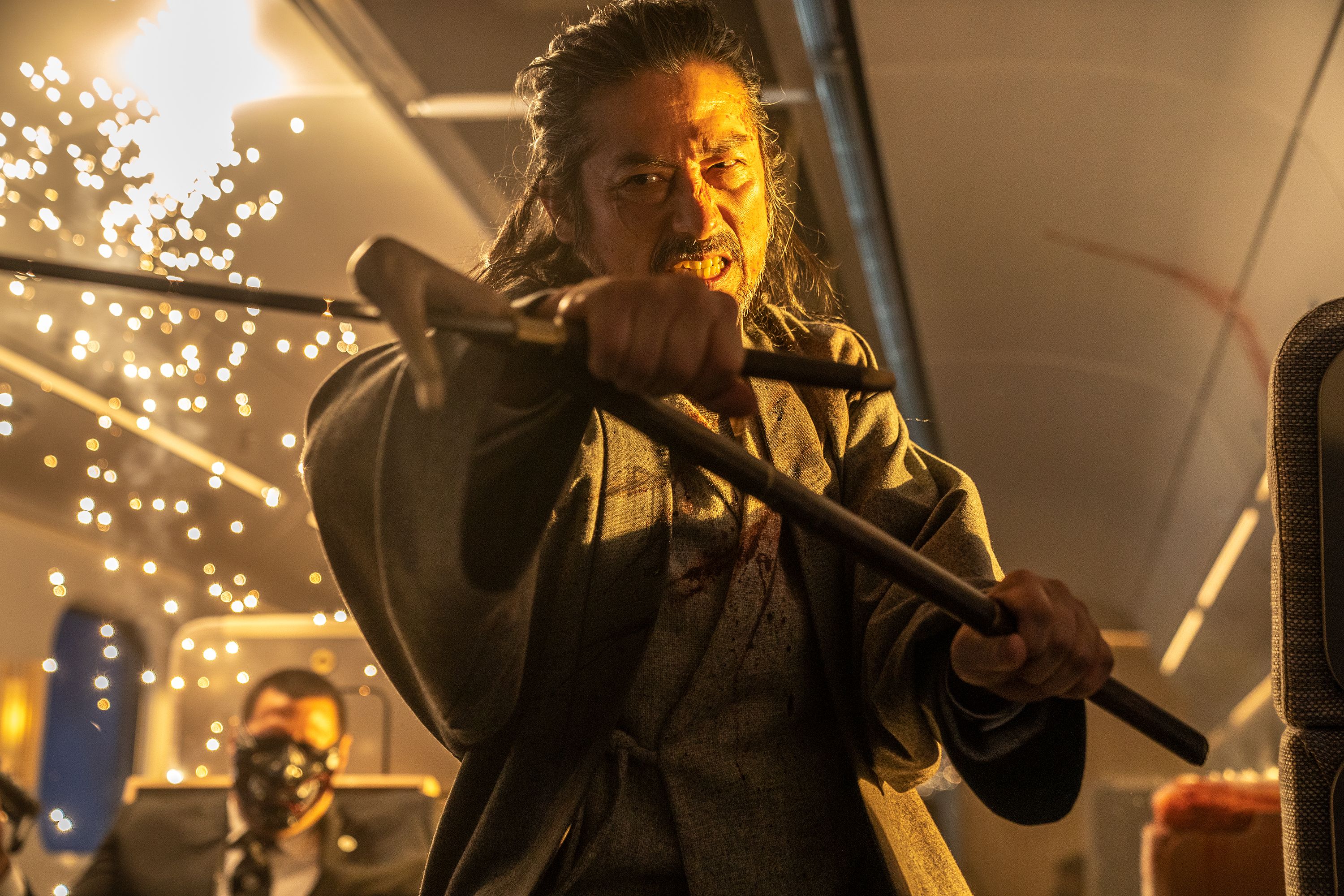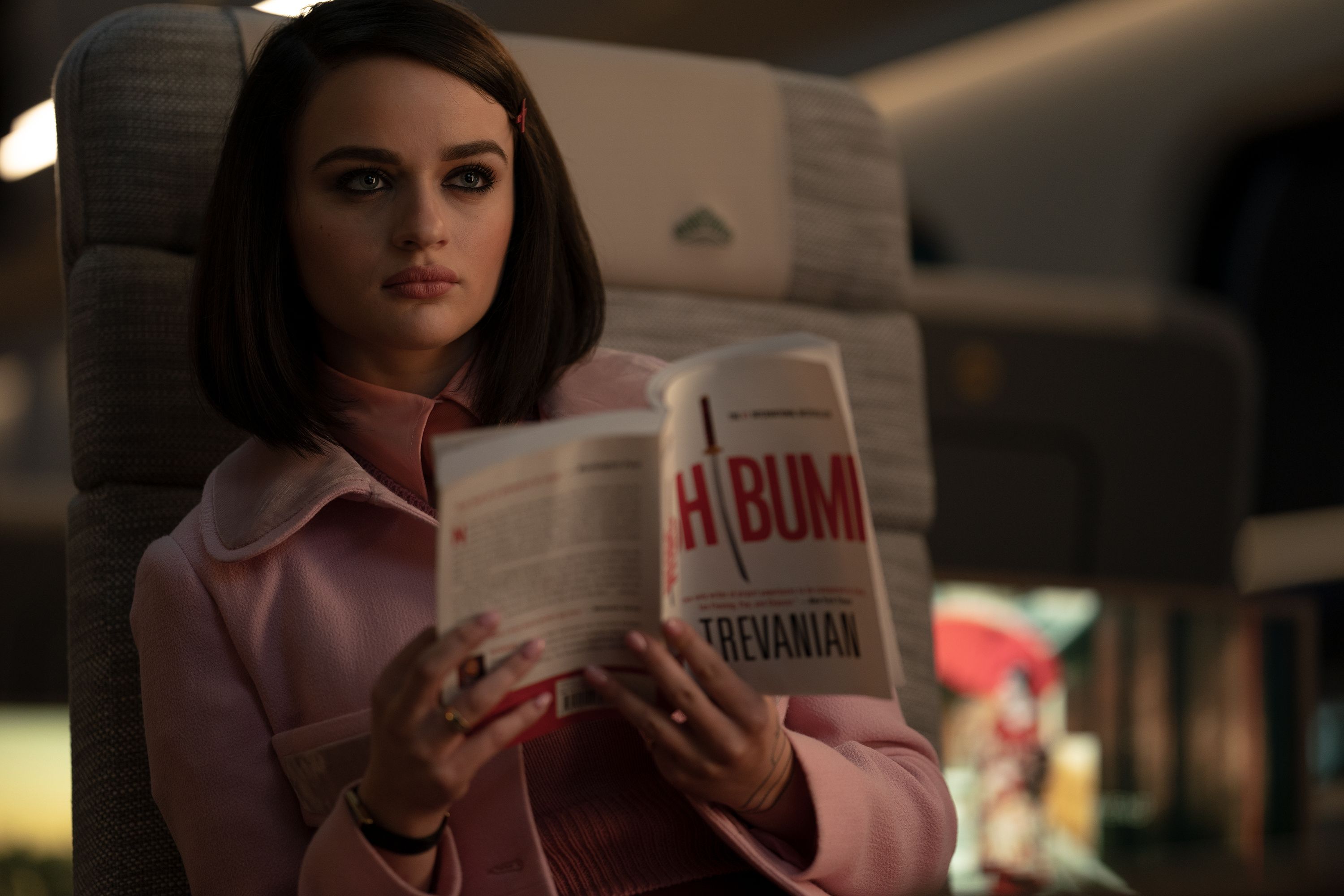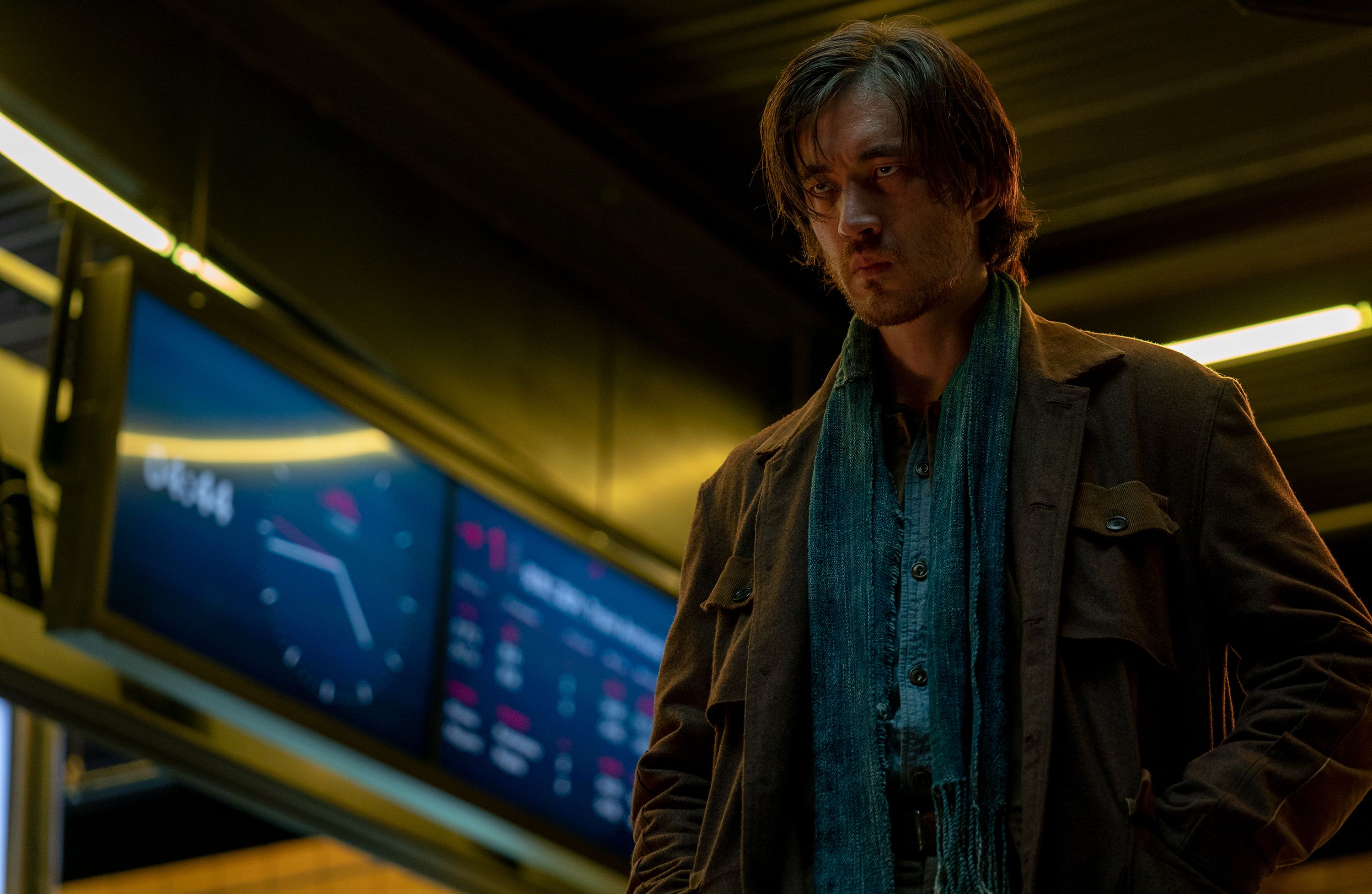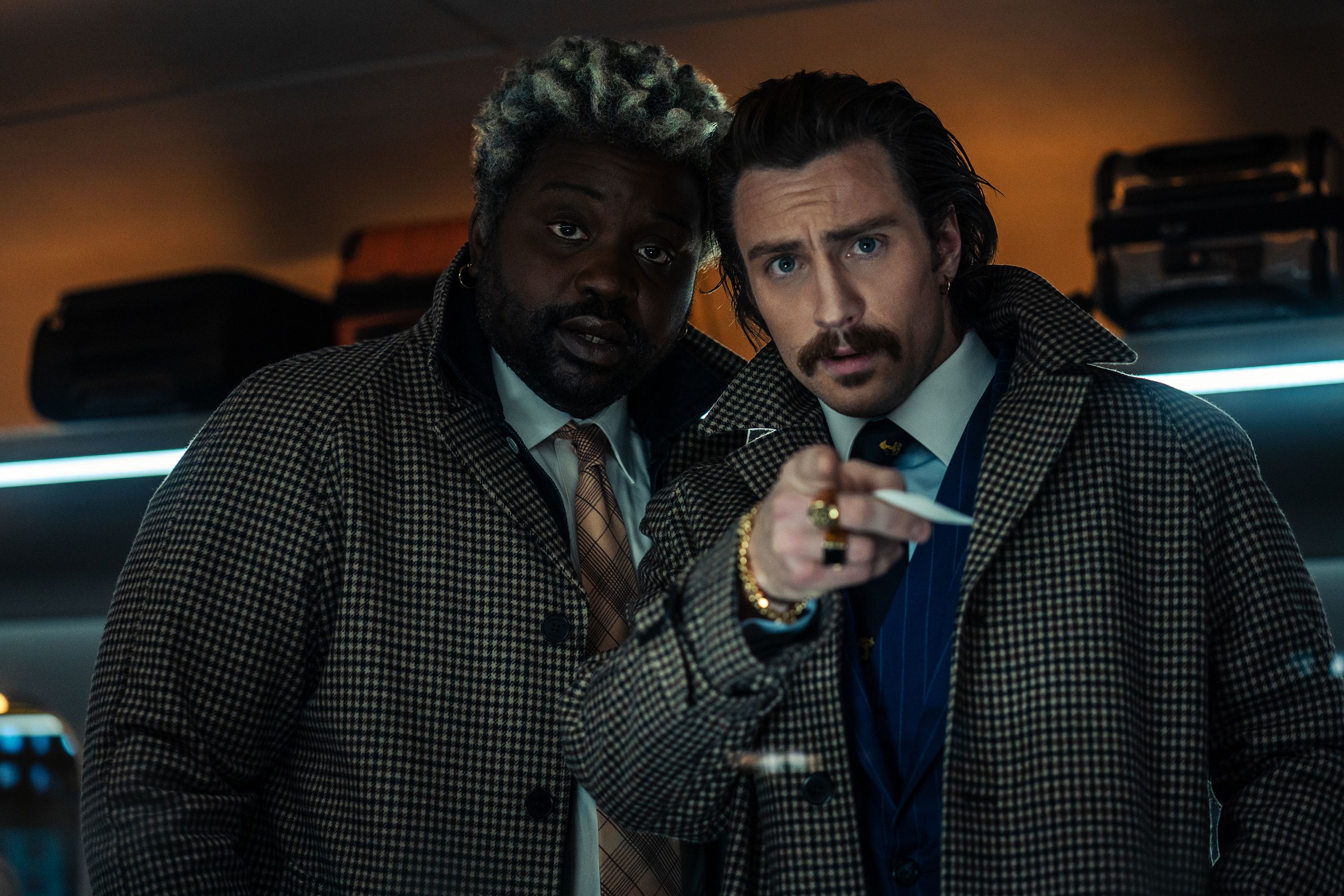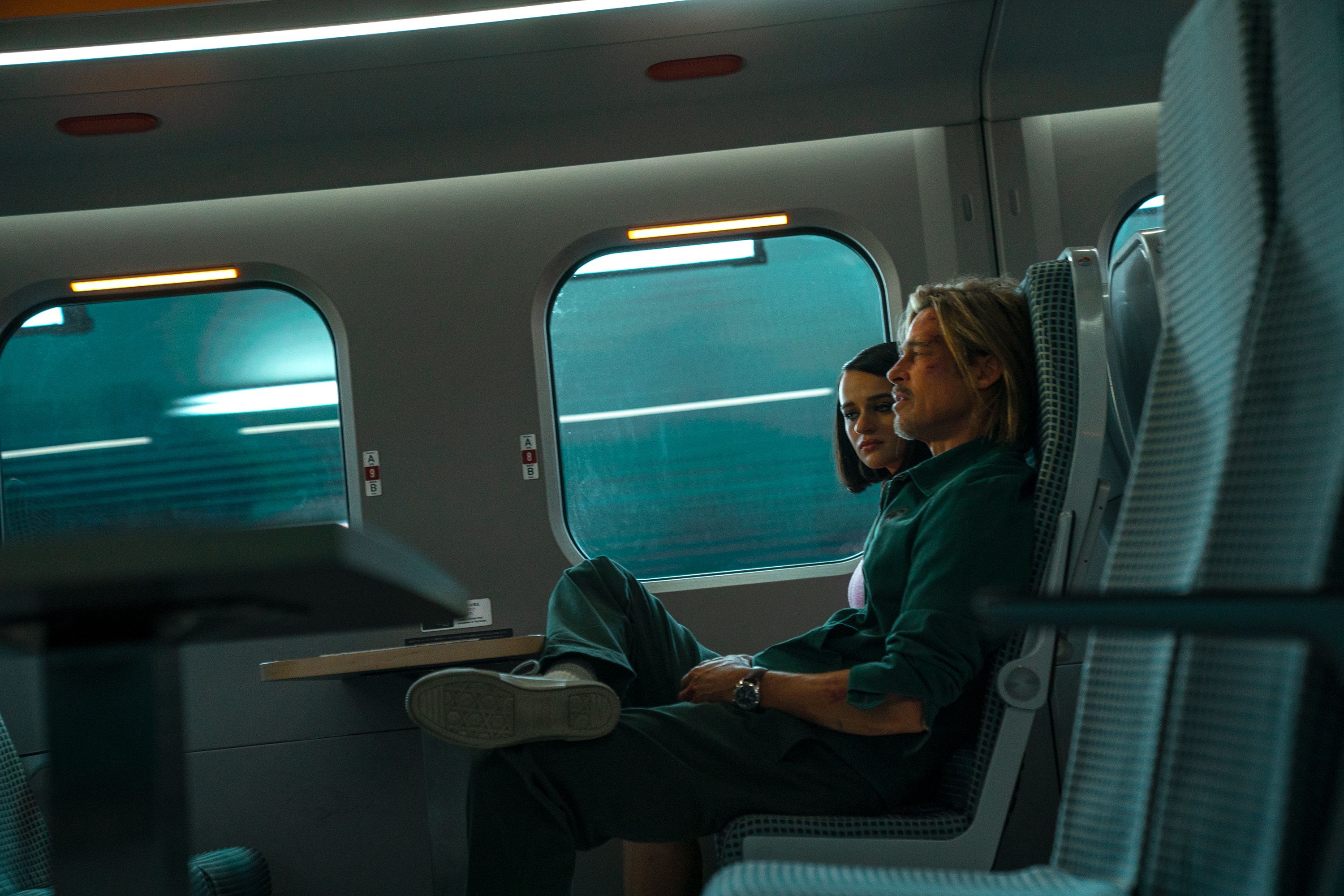Right before Bullet Train opened in theaters and IMAX, Collider held a special screening at IMAX HQ in Los Angeles. While getting to see the movie before it was in theaters was cool, the best part was after the movie ended, director David Leitch and producer Kelly McCormick sat down with me for an extended Q&A to break down the making of the film.
During the fun and informative conversation, they revealed why they made Bullet Train after Hobbs & Shaw, Leitch’s history of being Brad Pitt’s stunt double, working with Pitt and Bad Bunny, the new technology used on the film, why they love IMAX and if they’ll use it on their next film, The Fall Guy, with Ryan Gosling, how they pulled off filming most of the movie on a Sony soundstage in Culver City, and how they stage action. In addition, they talked about future 87North projects and so much more it’d be impossible to list it all here.
If you haven’t seen the trailers, Bullet Train was adapted from the Japanese mystery-fiction book Bullet Train written by Kōtarō Isaka, the Japanese best-selling and award-winning novelist. Just like the novel, the movie takes place in Japan on the titular bullet train on a trip from Tokyo to Morioka. On the train there are a number of assassins whose assignments are very much interconnected, though they don’t know this until things start to go haywire when the assassins start trying to kill each other.
Loaded with inventive action set pieces, a script that will keep you guessing, and fantastic performances from the entire cast, Bullet Train is absolutely worth seeing in a movie theater. The film stars Brad Pitt, Aaron Taylor-Johnson, Brian Tyree Henry, Joey King, Andrew Koji, Hiroyuki Sanada, Zazie Beetz, Michael Shannon, Logan Lerman, Hiroyuki Sanada, Masi Oka, Sandra Bullock, and Benito A Martínez Ocasio aka Bad Bunny.
Trust me, if you’re curious how Bullet Train was made, or just want to hear some cool behind-the-scenes stories, you should push play on the video above or read the conversation below.
COLLIDER: I want to give a huge thank you to IMAX and to Sony for letting us do the screening, and to you guys for coming out. For people that don't realize they flew in for... are you guys here for just a few days.
McCORMICK: Yeah.
LEITCH: Yeah. We have to head back to Sydney, soon. Friday, but yeah, just a few days for the junket and stuff.
So we got very lucky getting them. They're going to do the Fall Guy with Ryan Gosling in Sydney after this.
LEITCH: Yeah. Starting in October.
So jumping into, how did you guys actually decide that this was going to be the next project?
LEITCH: Oh, Kelly?
McCORMICK: Well, we were looking for something that we could... the film business had the opportunity to go back to work sooner than a lot of industries did, for better or worse, and considered an essential industry.
LEITCH: We were essential workers at that time, at the height of the pandemic.
McCORMICK: And we really wanted to get our film family back together and we thought it would be great if we could find some contained project that allowed for us to get going sooner, actually, and safer, to be honest. Because we started before the vaccine came into play, so we were figuring out a lot of the rules and regulations to keep people safe along the way. So we thought that was a really good idea to do that. And then this script comes across our desk right around the same time, and it happens to be perfectly contained and also gonzo and awesome. I read it first and sort of forced David into doing it.
LEITCH: Not at all. No. I mean, it was like gunpoint, but it was not at all. No, it was a challenge because we saw all these crazy characters and it was like, how are you going to service seven stories? And we had a lot of conversations about how are we going to, first of all, logistically, like she was saying, we're going to make it on a stage at Sony, that sounded great. And then you start to really analyze the protocols and then you're like, yeah, but we're on a sound stage where we can contain everybody. We're also in a tube where we're right next to each other, so it also had its problems with COVID. But film crews figured that stuff out and we found great protocols, great ventilation. We made the sets modular, all those things, but back to why we did it-
McCORMICK: And didn't miss a day, which a lot of people were shutting down for long periods of time at that point. And our COVID specialist told us it was because we had a really old crew. Super boring and really old.
LEITCH: None of the crew was going out at night. They were all just going home and bubbling up with their families. We weren't rowdy, I guess, so that's why we avoided COVID. But no, look, it was great characters. Zak Olkewicz had really made the characters come to life from the book and that was our entry point into it, the script. And then we went back and rediscovered the book and the great stuff that Kōtarō Isaka had in it. And it just made sense. It was really in our wheelhouse of stuff we love to do.
For people that don't realize, you were Brad's stunt double for a long time. And you worked as Brad's double on Fight Club, if I'm not mistaken.
LEITCH: Yeah.
McCORMICK: He did. And they've talked about it a bunch on the junket and there was one really cute thing that happened during our junket where Brad and a couple of the cast were talking about stunt movies. And they just brought up out of the blue, oh, you know that thing in Bourne Ultimatum where the guy runs through all the windows and he is chasing and the camera's chasing him and he jumps and all this stuff.
LEITCH: Yeah, I was there.
McCORMICK: I go, "Yeah. That was David Leitch." And they're like, "No way." It was so cool. I was like, "Oh yeah, that was your director."
LEITCH: Even with Brad, that first Fight Club movie was a huge moment for me. I had been doing a lot of television. Buffy the Vampire Slayer fans in here, anybody? Yeah. I wore a lot of prosthetic makeup. I was killed about 47 times on those TV shows. But then I ended up, I got a chance to work on Fight Club as one of the fight choreographer trainers. David Fincher really wanted the actors to get in there and learn the physicality of fighting. There wasn't a lot of fights in that movie, but it was more of he wanted the intention from those guys. So we were training Brad and they're like, we need a double, and was standing next to him and they're just all like, what about him? Yeah, he'd be great. And then, wow–
McCORMICK: He was a lot skinnier then.
LEITCH: Wow. Ouch. I was. But five movies later, we went on a run. We did Mr. and Mrs. Smith. We did Troy and we had great times around the world doing really cool big movies.
McCORMICK: The Mexican, great story.
LEITCH: The Mexican, yeah, great story.
Well, what I'm curious about is everyone in Hollywood is looking to cast Brad in a movie. He gets sent every script in town and basically, you know, he gets offered everything. So did your history give you the leg up to getting him in this movie? Had you been talking about working together for a while?
LEITCH: We had. I was really humbled to find out, he'd been watching my career since I started to move into second unit directing and directing. Obviously, John Wick, Atomic Blonde, he knew those things. We reunited on Deadpool 2 for that cameo. And he was like... He was a huge fan of the first film and he was also a fan of Ryan's, and so to get him to do that, we got to reunite again. And he was just starting to see me as a filmmaker. So yeah, then it was a touch point, hey, we should find something.
McCORMICK: Well, he also sent a spy in. Because during the Hobbs and Shaw reshoots, he has this old time, I mean, since the beginning of time, I should say, makeup artist named Jeanie Black, who's amazing. David and she were friends back in the day, too. And she came in and did Jason's makeup on our reshoots–
LEITCH: For Hobbs and Shaw.
McCORMICK: She's usually not available. She does Julia Roberts. She has all these people. She's always busy. And she came and she says, "I'm spying. I got to see if Leitch has got it. I think he might." And so I really think she had something to do with it as well.
LEITCH: Jeanie, we've always been close. I mean, because again that time, she's been with him forever. For sure, I think she definitely, if she puts in a word, it means something in his world. Yeah, we had a blast on Hobbs and Shaw and I think she saw the way I run a set and the way I work with actors and that Brad might like that experience. But ultimately, I think it came to the material and if you get a chance to ask him and he's been talking about it in the tour, he really responded to the script, too. And he is a material first guy and he loved the characters and he loved sort of the irreverent idea of what this movie could be, and try to make something fresh and original. And that was why he responded.
I'm going to throw a curve ball right now.
LEITCH: Go ahead.
I meant to ask this at the beginning. Obviously people want to be in business with you guys. You've been on a role with films…but if you could get the financing or the IP to do anything, what would you make and why?
LEITCH: It's hard. I mean, look, I'm going to dodge this question. But then I'll answer it. I think what's been really fun with Bullet Train is having now a chance to express myself outside of two different franchises or franchise expansions or whatever you want to call Hobbs and Shaw. Those were really great experiences with great people and put different creative constraints on me as a storyteller, but also gave me resources I never would have if I wasn't in that space, but Bullet Train was so fun because the IP was relatively unknown, obviously, here, and we got to do something that was really original.
So finding those ideas and really getting to express yourself is what's interesting to me, but there's a lot of IPs that are out there and that I've always wanted to do. And I've circled some in the past and I've attached to some and they fell out and I would just hate to soil their names because I hope they come back again. I don't want to dangle them out there to the universe and like, ‘God, I wish I could do that!’ because maybe they'll come. But there are, there's stuff.
Kelly, do you want to answer?
McCORMICK: No, I abstain. There's too much pressure and there's a lot of... I mean, there's so many amazing stories to tell and some to retell and I just believe that... We don't really do that five year plan thing. We just sort of look at some things that really sing to us in the moment and try to go with that, and so far we've been really lucky that way, with both known IP and franchise and then also originals as well.
You touched on it a little bit, but I think that to be very clear for people that don't realize. 96% of this movie was shot on the Sony backlog on a sound stage. Talk a little bit about how using technology to help tell this story, I believe I read that you were using old school projection with new LED. Can you sort of take us through how did you pull it off doing all of this on a sound stage?
LEITCH: I'll get into it. I mean, that was part of the problem opportunity. I'm by nature, I think my years of being a second unit director, I am more of an organic filmmaker. I want to go to the location and then I want to be inspired by the location and I want to shoot in that location and I want to bring the crew to that location. And so, the bringing me to a stage is kind of like the last thing I want, but we didn't have a choice. So it really was an opportunity for me to explore some of the new technology. The first thing we explored was the virtual production screens, virtual...
The LED stuff or the volume?
LEITCH: The LED walls like they had in Mandalorian. Lux Machina came and we worked with Unreal Engine. Ultimately we found out we didn't need to track the cameras. I mean, the parallax wasn't, this is getting technical, but it wasn't so much that we felt like we had to track the camera with Unreal. So we were really just using the LED technology and we shot plates before production of the trip from Tokyo to Kyoto. And we augmented them, because you can see it's a stylized version of Japan, but we did all that augmentation and adding the light and color correction and adding buildings and things. But we created this journey, in 3D, and then we just projected it on the outside of the window, so every shot is like you're shooting on a train. There's no comp, blue screen comps. That's all just in camera with rear screen projection, but the new version of that, which is LED monitors.
McCORMICK: Yeah. People got motion sickness because it was like they really felt that they were on the train a lot.
LEITCH: There were actors that just didn't like it. And there were others that felt it was really immersive. I mean, the things that it gets you from a technical side is you get a lot of interactive light and all the kicks off all the surfaces. It's stuff you can't create in visual effects, or it's really difficult to create that type of interactive light without having light. And now you have a comp and the light, it's actually a pretty spectacular tool.
Kelly?
McCORMICK: I think it worked too, to the movie itself, in the sense that it's a heightened world. It's a fable. When you first read it's like, oh my gosh, we're going to go to Japan and this is going to be amazing. I think that version–
LEITCH: Wah-wah.
McCORMICK: –is much more grounded, naturally. And I think the movie for us is a fable. You're supposed to be taken away and go for all of the philosophical sojourns that are happening on the train. And I think that actually being forced to shoot in the LEDs and virtually allowed for you to really maximize that feeling of it being just heightened and not of this world kind of.
LEITCH: For sure. I mean, it actually led us to a lot of the design of the movie in terms of the color palette and the heightened style. And even being in that environment with color palette, heightened style, heightened costumes, the tone of the movie lifted when the characters came on set, when the actors came on set and we really felt that mood change and we were in a live action anime sort of vibe. That's what we were going for.
You've worked with your DP Jonathan Sela on all your projects. How did you ultimately first decide you wanted to work with Jonathan, and talk a little bit about working with him on this, on the color aesthetic, and what you were going for and what you wanted each car to look like?
LEITCH: Okay. First time I worked with Jonathan was one of my first second unit jobs. It was on a–
McCORMICK: Midnight Meat Train.
LEITCH: –Midnight Meat Train. It was a horror movie with, oh.
McCORMICK: Bradley Cooper.
LEITCH: Bradley Cooper. Yes, you got it. And Ryûhei Kitamura was the director, who I absolutely love. Jonathan was this incredible DP. He's really quiet. And he's very meticulous and he has great composition. And on that movie, I was just fascinated with his choices of composition. And so it always stuck with me and we had a great relationship, even though he wasn't my DP. He was the first unit DP. When Chad and I got the opportunity to direct John Wick, I said, "We got to call my friend Jon Sela." And he's like, "I don't know Jon Sela. Who's Jon Sela?" and then I showed him Midnight Meat Train. And then I showed him the Die Hard that he'd shot, and he's like, "Holy shit. We got to call Jonathan Sela." And Jonathan has this extensive... He's kind of a legend in the music video world, so he comes from a super stylized upbringing in cinematography. So we love to dabble in color and heightened color and cool composition and camera moves. And we really have fun [with] that as part of our narrative toolbox.
We often do a color palette for all the scenes. From John Wick, Atomic Blonde, they've all had color wheels of what we want the scenes to be and how it's going to arc through the movie. And Bullet Train was no different. We worked closely with production designer, David Scheunemann, who's been on all of our films since Atomic Blonde and it's sort of our color geekfest. We love it.
McCORMICK: Yeah. I mean–
LEITCH: Maybe the next one will be more natural. We'll see.
McCORMICK: To the second part of your question, I think one of David's trepidations entering the project at all was how he was going to entertain anyone for two and a half, two hours... It's actually two hours. Good job. It's two hours.
LEITCH: I just made it– It was 2:05 with credits.
McCORMICK: I think he said two and a half when we started. Actually, it's absolutely two hours. That's awesome.
LEITCH: It needs to be under two hours.
McCORMICK: How are we going to entertain them? They're going to be on a train the whole time. It's going to get really sort of tedious. And so it was critical to create worlds within each train and train car. Hopefully you feel a lot different when you're in the economy car, versus the first class car, versus the lounge, and Momomon, which is my favorite car. And sometimes the action that's happening there or the emotion that's happening there fits within the vision of that car, and sometimes it's completely juxtaposed to it, but that was really important to the design of the movie.
You guys have Bad Bunny in the movie and–
McCORMICK: How good is that guy? How good was that guy?
LEITCH: Come on. Bad Bunny. What?
But the thing about it is, you couldn't have known, he's gotten even more popular since filming this movie.
LEITCH: Kelly McCormick knew.
McCORMICK: I didn't know. I didn't know.
LEITCH: You totally knew. That was one of her many big ideas. That was a huge idea. I had this vision of this grizzled old, the wolf. And he lost the love of his life, he'd been with for 20 years. And it was his old grizzled passion and she's like, "Nah, we need to like find the young passion. It's first love. That wolf's going to be way more tragic." And I'm like, "Oh, who are you thinking?" And she's like, "Have been talking to Mary Renieu." Great casting.
McCORMICK: Amazing. Legend.
LEITCH: Had said that Bad Bunny had done this stint on Narcos. And so, Kelly–
McCORMICK: And also his music videos and also his songs. I mean, there's so much passion in all of it, and he performed so well. He's just a natural performer, I think. And so I was like, I think we should go for him.
LEITCH: Yeah. We reached out. We got on a Zoom. He read over the weekend. And he's a rock star. But he read over the weekend and he's like, "I'm going to get to work with Brad Pitt?" I'm like, "Yeah, this could be really fun. Come on, let's do it." And he's like, "Okay. Yeah." And he came like a consummate professional, I think a lot of those guys are. That's how they get so successful. I mean, his work ethic is off the charts and he came and trained with us for three weeks to work on the fighting, and then we had to shoot that whole, this non-verbal story that I wanted to tell visually. Wanted to build up the expectation of this character and obviously rip the rug out. So he was with us for three, four weeks.
McCORMICK: Yeah, actually I think we had a COVID hiccup in the middle of it and had to switch some stuff around, so he had to come back and he was just absolutely in for it all. Worked his booty off. I mean, he's such a pro. We love that guy so much and we've gone to his concerts since, and we are the oldest people who go.
LEITCH: We are the oldest Bad Bunny fans. But his concerts are awesome. And he's going to be in SoFi–
McCORMICK: They are amazing.
LEITCH: –in November. Everybody go.
McCORMICK: Everybody knows every word. It's so cool.'
A lot of action in this movie, obviously. Talk a little bit about how early on, before production begins, are you staging these sequences and working with stunt teams? And can you take us through how early are you doing all this?
LEITCH: It depends on the movie. I mean, Bullet Train was its own animal. I think because of COVID we had a lot less time to prep. And luckily, the scenes on this train were really in my wheelhouse. It's fighting stunts. It's things I've been doing for 30 years. And so I had a lot of ideas and I had the tone where I wanted to go. We were sort of like this homage to Jackie and Buster Keaton and all of those fun, physical comedy beats that we were trying to get.
I think we had eight weeks with the stunt team, which, again, is not a lot for a big stunt movie. It really isn't a lot. But again, it was really fight based stuff. They were working in masks and the weird protocols that we had at that time, and everyone has to test every day. And it was just a weird... Because choreography's tactile. It's people in a room kicking and punching each other, trying stuff. Choke this guy. That choke doesn't work, try this. Oh, where's the comedic moment? Hands in the face and all that stuff during COVID, before the vaccine, was all weird, even for stunt people. Somebody tests positive and everyone was freaking out. And so we took this... this was very methodical and very different. A big movie, these big action movies, and Tim [Miller] would know, you do months of previs and rehearsing with your stunt team and they're on for, they can be on for three, four or five months.
We're talking about someone in the audience.
LEITCH: Oh, sorry. I didn't know.
TIM MILLER: Well, I just roll out and shoot it.
McCORMICK: I mean, the other thing that was different about this is, usually you're also... a lot of times you're shooting with the same character for... in this case, there were a lot of characters that came in and out or only had one big sequence. That allowed you to actually prep for... Here's me talking as a producer as budgetarily speaking, it allowed you to prep a little bit shorter at the beginning of the movie. Because then when the actor would come in, you would need a few days with that actor to get them primed for what they were to do with their scene as it was coming up. So it was very episodic that way, the movie is a bit episodic.
LEITCH: The whole production train, the train is rolling, literally, figuratively down the track, but you're only shooting these two actors. Those other actors are off. They can be rehearsing. The stunt team's on for the whole movie, so they go to a different place and they... So your shooting time is often prep time. It's hard for a director because you're like, "What's going on? Where's that choreography? I want to see that. Has it changed?" But you're trying to focus on the scene. You try and get as much prep done as you can in the beginning of the movie, but it undoubtedly keeps rolling downhill and you're prepping and shooting until the very end.
McCORMICK: Or we are.
LEITCH: Maybe it's just me. He just rolls out of bed and shoots.
And I apologize for not knowing, did you have a second unit director on this?
McCORMICK: Yeah. Greg Rementer, who was with us on Hobbs and Shaw as well.
I was going to say, you've obviously done second unit. Do you consider yourself to be a micromanager or do you consider yourself to be like, I trust my second unit director, I'm good?
LEITCH: I trust them. I totally trust them. The guys that second unit for me are usually from my fight world and they've been on my choreography team and we've done a lot of stunt vis already or previs, and we know what the sequence is, so they're going to get the pieces we all agreed upon. And if they get inspired and they shoot something else, I'm usually fine with it because they're guys that I've been working with for a long time.
There's other movies, in Hobbs and Shaw, I had a really great opportunity to work with Simon Crane, and he did some great stuff in Scotland for a sequence in that. And so it's a very different thing on a big, massive movie like that when there's moving parts of I have a splinter unit here and a second unit where I am, and then I have to send a unit away. You just have to have trust in people and they had the right conversations and you get good stuff.
Do you actually think a Hobbs and Shaw sequel will ever happen?
LEITCH: I hope so. I mean, I think those guys together are awesome. I mean, I hope so.
I'm looking at Kelly and I'm trying to read her.
LEITCH: Well, just I don't want to bet on it. I don't know what the odds are. I mean, they're so busy. Everyone's so busy, but man, I think people had a lot of fun, and those two guys together are fire, for sure. The kids are saying fire.
McCORMICK: Fire. Yeah. I've heard at times that they're in development on something, but we haven't seen anything.
Yeah. The biggest problem with Dwayne [Johnson] is, what is he, scheduled out for two years?
McCORMICK: Yeah.
LEITCH: Yeah. He goes deep on his schedule, and he's got a lot of stuff.
So you know, and everyone in this room who's seen a Q&A with me knows that I like talking about the editing process because it's where it all comes together. Which of your films actually changed the most in the editing room in ways you were not expecting?
LEITCH: Ooh.
McCORMICK: Atomic Blonde?
LEITCH: Yeah. You think?
McCORMICK: I don't know. What were you going to say?
LEITCH: I don't know.
McCORMICK: Nobody changed a lot in editing, actually.
LEITCH: Yeah. Nobody actually. I mean, it's a film we produced, but that transformed during the edit.
McCORMICK: Yeah, there's one sequence that I could probably share about it. The director’s cut... has anybody seen it? Some people have seen it.
Bob Odenkirk.
McCORMICK: The Bob Odenkirk one.
It was fantastic.
McCORMICK: If you remember the opening of that movie where it's Monday, Tuesday, Wednesday, Thursday, Friday. And it's really the perpetual sort of drone of our lives and how you missed the garbage and all the shit that happens all week. So that, actually, David and I conceived of after the director's cut. Like, so not to take anything away from Ilya [Naishuller] because I don't think he's crushed.
LEITCH: No we pitched Ilya on it. Yeah. We pitched him on it.
McCORMICK: It was starting, kind of where the movie starts after that, was where it started, which is kind of into the family stuff and getting to know the family as they go and all that kind of stuff. And the movie, to us, was critical to understand that, for us, the movie's about that drone that people get into. That you settle into this life. You thought you were going for the American dream, you don't really do it anymore. You kind of go to the hum drum. You haven't really figured it out. And then something triggers you that shakes you out of that monotony and makes you kind of a better person, through violence, awkwardly.
You couldn't get that sort of rhythm of the regular life and the humdrum of what we all go through when you watched it, when we were sort of watching the director's cut. And so we pitched Ilya that idea and didn't do any additional photography. We just used the same footage to make it feel even more monotonous. And that, I thought, changed the movie so significantly and made it really kind of, really connecting in that way. That, to me, was one of the biggest things that we've changed.
LEITCH: Yeah. You make me think of something, because the way you enter a movie is so crucial. I don't know. One of the things that happened editorially with Bullet Train is that the original script was told in character chapters for the first two reels. So you'd meet a character, you'd go all the way back. And then you'd meet another group of characters and you go all the way back and you'd meet another group of characters and you'd see them all walk past each other. And so the way we had shot it, you would always see the other characters in the other person's scene, but you'd stay with those characters.
And we were just feeling we really wanted to get into the movie faster. We wanted to be with Ladybug sooner. We wanted this momentum to fall forward. They were all so interconnected that Elizabet [Ronaldsdottir], our editorial partner in crime who does all our movies, was like, "We should intercut this stuff and just get on with it. It's really cool how they pass each other and let's just go back and forth and people will follow the narrative and it's going to be great." So she took a stab at it, because I was a little reluctant because I liked the elegance of the chapters, but then once you see that change, it becomes undeniable. You're like, oh, that's the way the movie was supposed to be. You find all that stuff in post. And that's what I really love about post. You can find just some magic things that you never thought would change your movie.
Did you have a much longer first cut? Did you end up with a lot of deleted scenes?
LEITCH: There's not a lot of deleted scenes, there's a lot of deleted material. The scenes were really long and, this movie in particular, I allowed this sort of play, improv. Obviously, you can see Aaron Taylor-Johnson, Brian Tyree Henry are just having fun, and their characters are really, they're into their characters and they are getting to the point, editorials helping us get to the point of those scenes, because they can chew it up. And it's funny and it's funny and it's funny and there's so many jokes and improvs on the cutting room floor. At some point you just got to like, okay, choose, because I'm going to choose this joke and move on. But no, I think the scenes just through great compression on Elizabet's part, there isn't many scenes that are gone, if any.
McCORMICK: No.
LEITCH: I think they're all there. They're just the essence of what they need to be.
So we're obviously in an IMAX theater, and this is being released in IMAX. Can you talk about the actual format of IMAX and have you considered shooting in the future using IMAX cameras for filming something in total?
McCORMICK: I think this movie in specific works really, really well in IMAX. There's so much going on and then... they worked really hard on the visual storytelling. When we spot checked the movie in IMAX, we actually–
LEITCH: I think we were sitting in here.
McCORMICK: Yeah. And we ended up watching the whole thing because we were seeing things that you hadn't seen before. There's one moment, if you remember, where Lemon spots the gun with the bobby, hair bobble on it in the backpack, and you don't see that as clearly on other screens. It's just so clear that he's connecting those dots. And then you see him put it back in and use his other gun, and that can be a little confusing because it's all going so quite quickly, and you can just see it so much more clearly. It's just one example. I mean, I think there's, in specific is doing a lot just without words and with the visuals that I think it is an incredible format for this film in particular.
LEITCH: And you say that and I wouldn't have thought about that in the beginning, because you always think of IMAX as like, oh it's great for these beautiful landscapes and these big scopey shots. And when we sat in this room, I just thought how compelling it is for a movie like this, that is actually a lot of great closeups and all this intricate detail and things that you have to follow, but the large format works incredibly well for it. So it's expanding my mind, actually, having this play so well in IMAX to what can I use it for and what would be interesting in my storytelling to use it for?
I look at what Jordan Peele just did with Nope. And I think about Nolan and what he's doing with the Oppenheimer and... I love IMAX. Obviously, I've been doing screening series here for forever. I like it when I push filmmakers and being like, so do you think you're about to shoot Fall Guy. Any thought about IMAX?
LEITCH: You put us on the spot here at IMAX.
McCORMICK: Right.
I do this on purpose.
McCORMICK: Actually Fall Guy would look amazing in IMAX. It's going to have some epic stuff in it, for sure.
LEITCH: Yeah. And I think that type of movie actually, now that you say it, Steve, lends itself–
McCORMICK: And we're going to shoot Sydney for Sydney. I'm trying to talk you into it now, too.
LEITCH: It's all locations. It's really a location driven movie. We're going to be shooting practical locations and we're going to be showing the city of Sydney and, yeah. I mean–
McCORMICK: Call Peter Kramer.
LEITCH: There we go.
I just think you can't recreate the IMAX experience at home. I have a decent TV and a decent sound system. I cannot recreate the experience of going to a movie theater and being submerged in this. It's f—ing awesome. Sorry for my language.
LEITCH: No, you're right. And I think it, again, as we look for, as filmmakers, to support formats that are going to keep encouraging cinema to bounce back and to stay alive, and then this is definitely one of the premier formats for that stuff.
Yeah. Hopefully you're leaving this theater with Kelly whispering in your ear.
McCORMICK: IMAX, IMAX, IMAX.
Before I run out of time with you guys though, because I know we're nearing the end, but you guys have 87North and I'm just curious, what's coming up over there that you're really excited about?
McCORMICK: This thing called Violent Night we shot in Winnipeg this winter, which is David Harbour playing Santa who has lost his Christmas spirit. And he has to beat up the naughty list to get his Christmas spirit back as you do. And it's really fun. It's really fun. Universal's going to release it around Christmas time. It's Tommy Wirkola directing and just a hoot. It's ridiculous. It's so fun.
Is it over the top violent or just violent?
LEITCH: Ooh.
McCORMICK: I think it's-
LEITCH: What's over the top violent? What's over the top violent, Steve?
McCORMICK: Is Bullet Train over the top violent?
AUDIENCE MEMBER: Yes.
McCORMICK: It is?
LEITCH: You guys saw Squid Game.
McCORMICK: Seriously. Have you seen Squid Game?
LEITCH: We're watching Netflix, Squid Game, the first episode people are getting executed and then I have a few assassins die who are complicit on a train and everyone's like, it's violent.
McCORMICK: Really naughty guys. Really naughty guys.
LEITCH: These people are like-
McCORMICK: Not that many guns. I mean-
LEITCH: I was surprised, when we got the response. Wow. Really?
McCORMICK: Hyperviolent?
I will say that, even though Squid Game is super popular, not everyone has seen it.
LEITCH: It sounds like everyone's seen it.
I have actually not seen Squid Game.
LEITCH: What? You need to watch Squid Game, man.
McCORMICK: You got to see Squid Game. It's so good.
There's only so many hours in the day. I didn't do a junket.
LEITCH: I know. I know.
It falls through the cracks. But listen, besides that, I know you guys are cooking up other stuff. And I know you opened an office in Hollywood for training. Talk a little bit about that.
McCORMICK: Yeah we did. We didn't have an office before COVID and then when things sort of felt like they were settling down, it was sort of like let's all get back to work. And the executives really wanted to, and we've always wanted to open another facility that's sister to... The one that David and Chad share is down here in Inglewood. And so we were like, let's do something sister to it, closer to where people live. No, I love Inglewood, don't get me wrong. But in sort of Hollywood, more by where the studios are so that maybe they can use it as a training facility as well.
And it was really hard to find a place. And then I was just looking around on LoopNet, if you've heard of it. It's this place to look for commercial spaces, and there was this church that had been converted into this kind of modern looking space and completely just renovated into just an openness with these beautiful windows. And I just was like, "We got to go check this place out." And then it ended up being available. We ended up converting it even more, putting a stunt floor in and a bunch of training equipment and our executives work out of there as well, and people call it the church of pain. And it's really inspiring and kind of Zen at the same time.
LEITCH: It's like Ladybug.
McCORMICK: Or spiritual. Yeah.
LEITCH: It's a path to enlightenment there. You can learn action, but you can put peace out in the world too. It's still a church, light from the windows come in.
McCORMICK: Yeah. It's pretty awesome.
Talk a little bit though–storyboarding versus finding it in the moment when you're on set. How much are you guys prevising the entire thing or, you know what I mean?
LEITCH: Yeah. For me, the way I work with Jonathan is we shot list and we talk about the composition. What I use storyboards is for exploration. I mean, I have some great storyboard artists. One I've been working with recently, Will Groebe, since Deadpool. I explore sequences from the script before pre-production starts, but I can keep him on contract and I can workshop ideas and just say, "Sketch out this idea for me." Because it's one person that can give me some visuals.
But once I get into production, for me, that starts to go away, because I see the location, I know the set I'm sitting there with Jonathan. We're going to be here. We're going to be there. We're going to be a close up here. It's going to be a 35 there. And we're just, we're shot listing. And it's very particular. It's like storyboards, but I don't feel like I need the boards anymore. Because I know, I see that the picture's already in my head if I have the words, so it's not... But it's very detailed. I like to start out like that.
And then what happens, ultimately, is you have an actor come in and they have an input and you're like, "Oo that's a better idea." And then part of that switches, the way you want to block something, and then you adjust to that. But maybe 75% of it changes. But I love to have the plan just coming into the day. I got 20 setups. These are exactly what I want. And then if it changes great, but I have a plan.
I totally understand. I apologize for saying this, but I believe we have to stop this Q&A because you have to go somewhere.
LEITCH: We do.
McCORMICK: Do we have time for a couple of questions, or yeah?
LEITCH: Yeah. Do you want to open it up?
. Does anyone have any questions? Oh yeah. Let me give it to Tim Miller right there.
LEITCH: Come on Tim.
McCORMICK: Tim.
LEITCH: Shoot.
For people that don't know, Tim directed the first Deadpool and this guy directed the second Deadpool. So it's a Deadpool family here.
McCORMICK: So cute.
LEITCH: It wouldn't have existed without you brother?
TIM MILLER: You're very kind. Back to editorial again. Because I wondered because you were all in one location because you had, I imagine, standing sets for all this, did it change the editorial process? Were you able to not have a lot of reshoots because you could go back and pick up little pieces? And it's really intricate with lots of little inserts to connective tissue, a beautiful little puzzle there. Did it help by having all that stuff? Did it change the process?
LEITCH: I like having standing sets for that reason. Like splinter unit, or you can go back I think. On every one of my films, it's always, the last day on stage is like–
McCORMICK: Mayhem.
LEITCH: –17 different pieces of set that are brought back out to the stage for an insert that's I'm thinking I need. We didn't have... Did we do any additional photography on Bullet Train?
McCORMICK: No, we didn't do any additional photography.
LEITCH: We didn't do any additional photography on Bullet Train, but we did have one of those days where it was like last day of school and get out the train cars, make this feel like the bar car, make this feel like the and put some smoke and some ashes here for the knife pickup.
McCORMICK: Brad was on like 20 sets that day.
LEITCH: And that's the fun thing about stage, is all the control you have and to solve those problems and a set can live. And you're right. You don't have to go back to a location. And now you're just reminding me that I'm doing a location movie. F—k. I have to go back to all those places, Tim. I'll never get that shit.
MILLER: No reshoots with all that little intricate stuff was impressive.
LEITCH: Thank you.
McCORMICK: Thank you.
LEITCH: Again, it went to the plan and the plan sort of it worked. We planned.
McCORMICK: We talked about reshoots for... Actually, that's not true. That button with Lemon is the one thing we shot.
LEITCH: Oh. The end.
McCORMICK: But we didn't even need it. Tom Rothman got all obsessed that we had to have Lemon live again. And so he was like, "Let's just go do this." And that's–
LEITCH: But we were incited by the tube.
McCORMICK: Yeah, we were super excited. So cute. And but yeah, that was the one thing we picked up, which is a Coda. So yeah.
LEITCH: Yeah. So we went and shot that Coda.
MILLER: Tom's idea, so who cares?
McCORMICK: Yeah.
LEITCH: You got it. He was like, "He should live." We're like, "That's a great idea. Will you pay for it?"
McCORMICK: I wish we could squeeze a few things in that we need.
LEITCH: And I built a bunch of little sets and shot inserts.
Let's do another. Do we have time for another question? Right here?
AUDIENCE MEMBER: I just had a question. First off, great movie. Probably one of the best I've seen all year.
LEITCH: Oh, thank you.
McCORMICK: Thank you so much.
AUDIENCE MEMBER: It's phenomenal. It's so great. I saw that music was a big deal within the action set pieces and another movie that does that really, really well is Edgar Wright's Baby Driver, which is one of my favorite movies of all time. And I was wondering if did you have any inspiration from that? Or how important was music to you when it came to writing the fighting sequences or just any of the scenes?
LEITCH: Music's always a big part of what I like to do. Atomic Blonde is the perfect example. I mean, the soundtrack sort of drove the movie for me visually. The soundtrack I wrote into the script and it really never changed. It was in the DNA of that movie. So I do use it as a jumping off point.
We have a great composer on this movie, Dominic Lewis, who was super inspiring and he was creating suites of music for the characters before I started. So we could play them on set. And I was trying to find a sort of a needle drop vibe in the score. So every song, even it's a piece of score, it feels like a song that you may know or something from the past or different types of music, but it felt like a song. That was our approach. And we created all these suites of material for our characters and I played them and we'd start to identify them and then he would refine them. And as we got into post, then we really refined it. So yeah, it was a long process.
McCORMICK: Yeah. There are actually are maybe fewer needle drops for David in this one than usual. And part of it was because just Dom was coming up with this amazing stuff and we kept dropping needle drops. It was like, that was so much better than the idea that we had.
LEITCH: The song for the Wolf is an original piece by Dominic Lewis. And then we ended up getting an incredible artist to sing it, Alejandro Sanz, who's an incredible Latin singer. He loved the song so much, he came on to record it for himself. I don't know. It was one of those fun creative explosions with Dom. He created this.
McCORMICK: I don't know, Engelbert Humperdinck sings the Bubbles in the 17 kills. That guy's 82 years old. He came in and recorded the music and he put bananas behind his headphones because it's the way he hears better. And he's just such a legend. He's still performing. And he's such a cool dude. We had a lot of amazing singers come in for this one. It was pretty special.
Can we do one more, or are you?
McCORMICK: One more, one more. That guy's been raising his hand.
You guys pick.
LEITCH: Right here. Let's do it.
AUDIENCE MEMBER: Appreciate you. Thank you.
LEITCH: Of course.
AUDIENCE MEMBER: Amazing film, by the way.
LEITCH: Thank you.
McCORMICK: Thank you.
LEITCH: Tell your friends.
AUDIENCE MEMBER: It's very simple question. I guess I wanted to know, both of you, who were your favorite characters and what was your favorite stunt achieved in this film?
McCORMICK: Who is yours?
AUDIENCE MEMBER: Okay. Okay. This is great. This is great. Okay. I got to take Ladybug, you know what I'm saying? I mean, I have to take him out of the way because he's amazing. So I'm going to say, I'm going to say Lemon. That's my guy right there.
LEITCH: Yeah. Lemon. We have a big.. we have a lot of feels for Lemon, for sure. These two sociopaths come together and they have this brotherhood and you obviously care about them. It's so crazy. To be in a movie like that, and then they give me these performances during their death scenes where I'm actually feeling something. I'm like, holy crap. I didn't want to undermine it. I wanted to just let you sit in it. Even though this is a bonkers, crazy, broad movie, I wanted you to feel those emotions with them because the journey's more satisfying. So hats off to Brian and Aaron for their characters.
McCORMICK: Yeah, for sure. I think we love all the characters. It's really hard to pick. And that was the hope is that somebody would connect to somebody in one of these characters in some way, or maybe all of them in different ways. And that's what we were really trying to do.
LEITCH: The Elder's pretty cool, too.
McCORMICK: He's a badass.
LEITCH: Hiroyuki is a badass.
McCORMICK: He knows everything.
On that note, I know you guys have to go to something else, so ladies and gentlemen, please, David and Kelly.
LEITCH: Thank you, guys.
McCORMICK: Thank you guys very much. Tell all your friends.
LEITCH: Glad you got to see it.

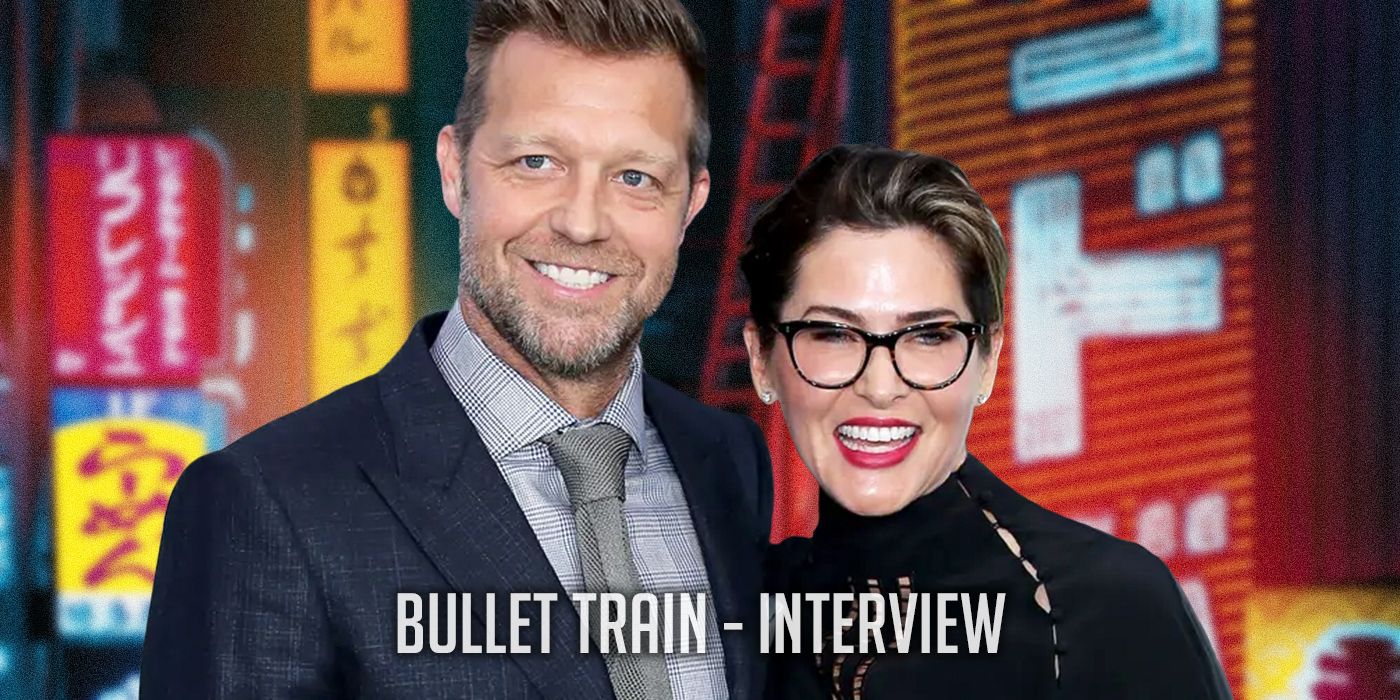
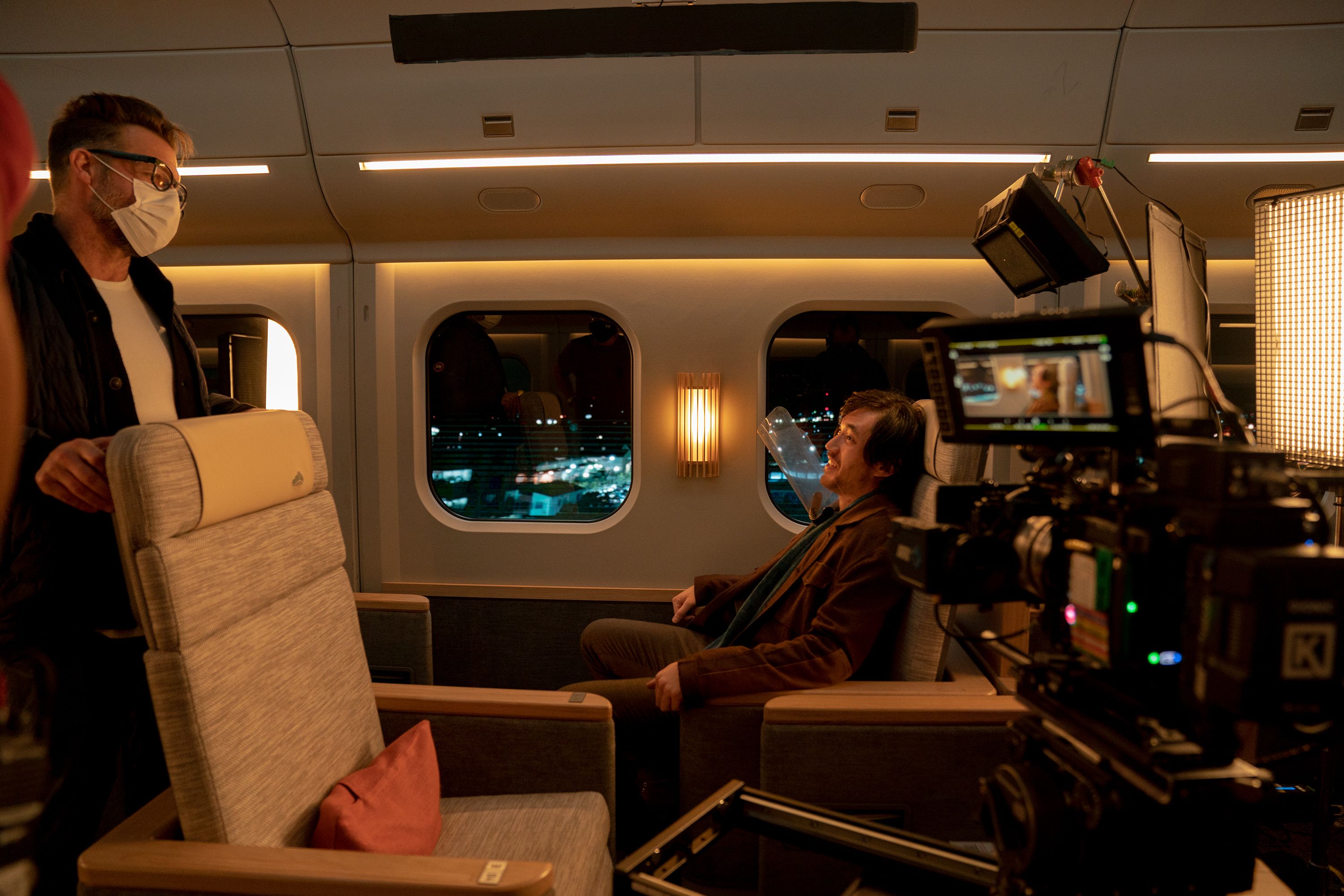
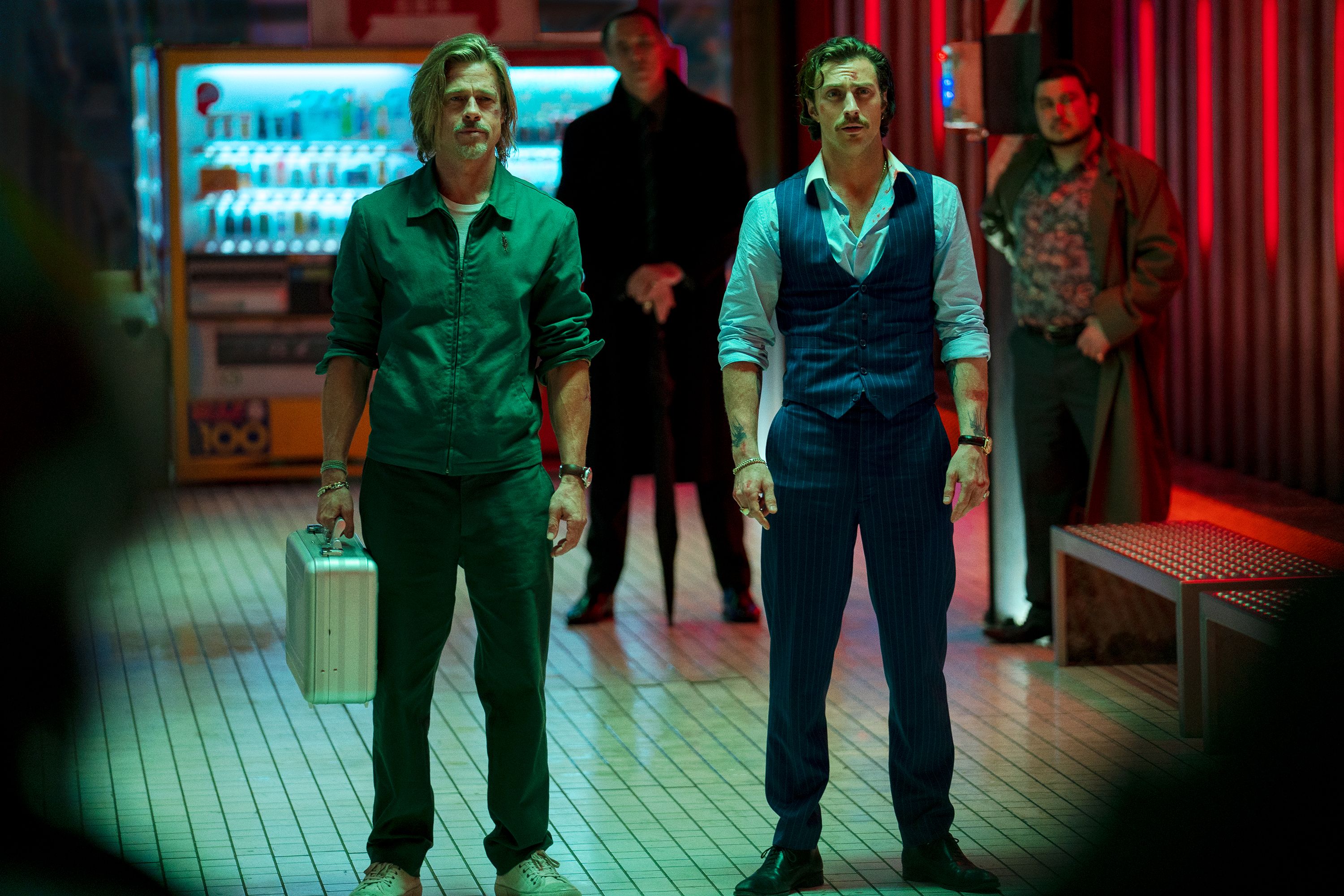
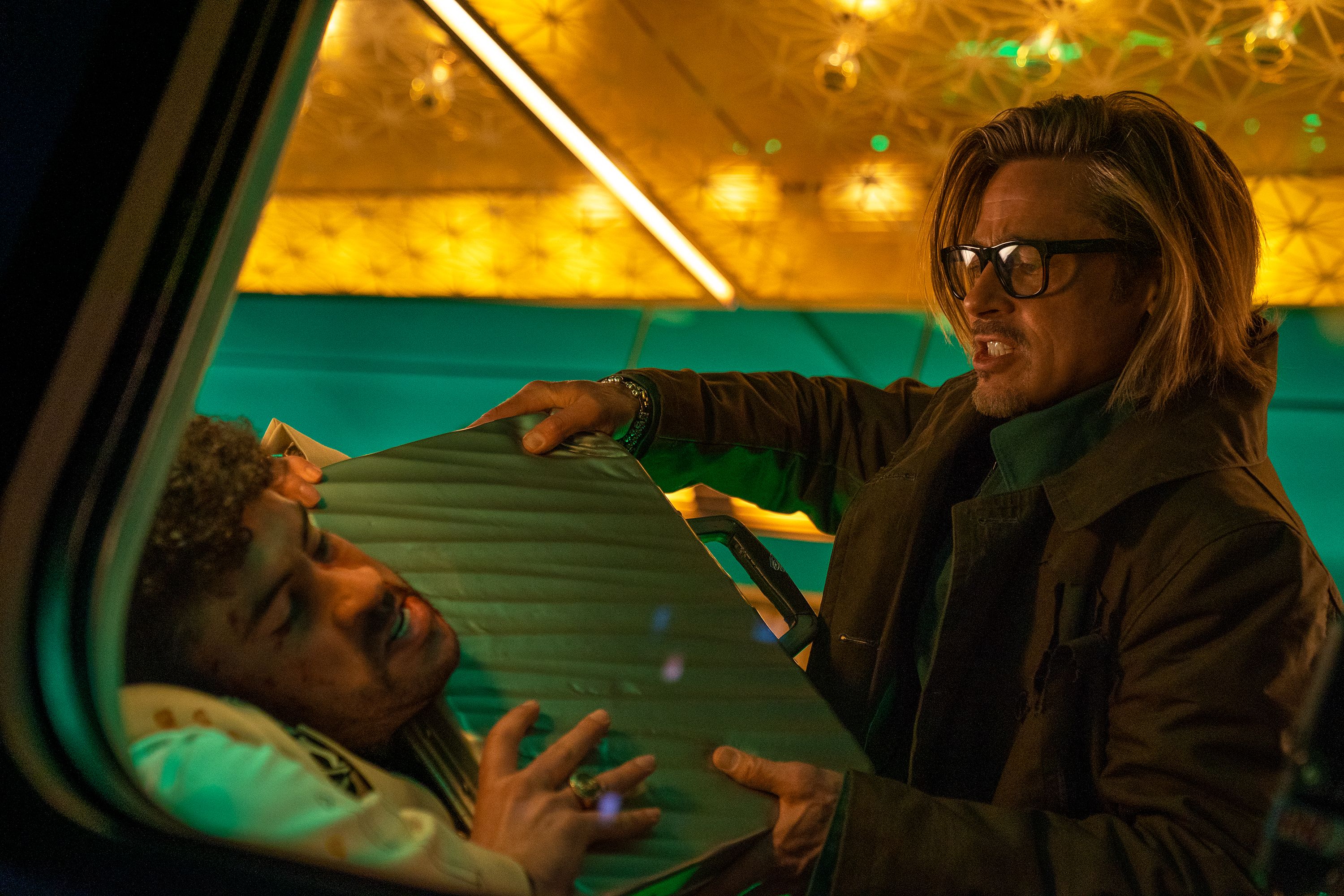
.jpg)
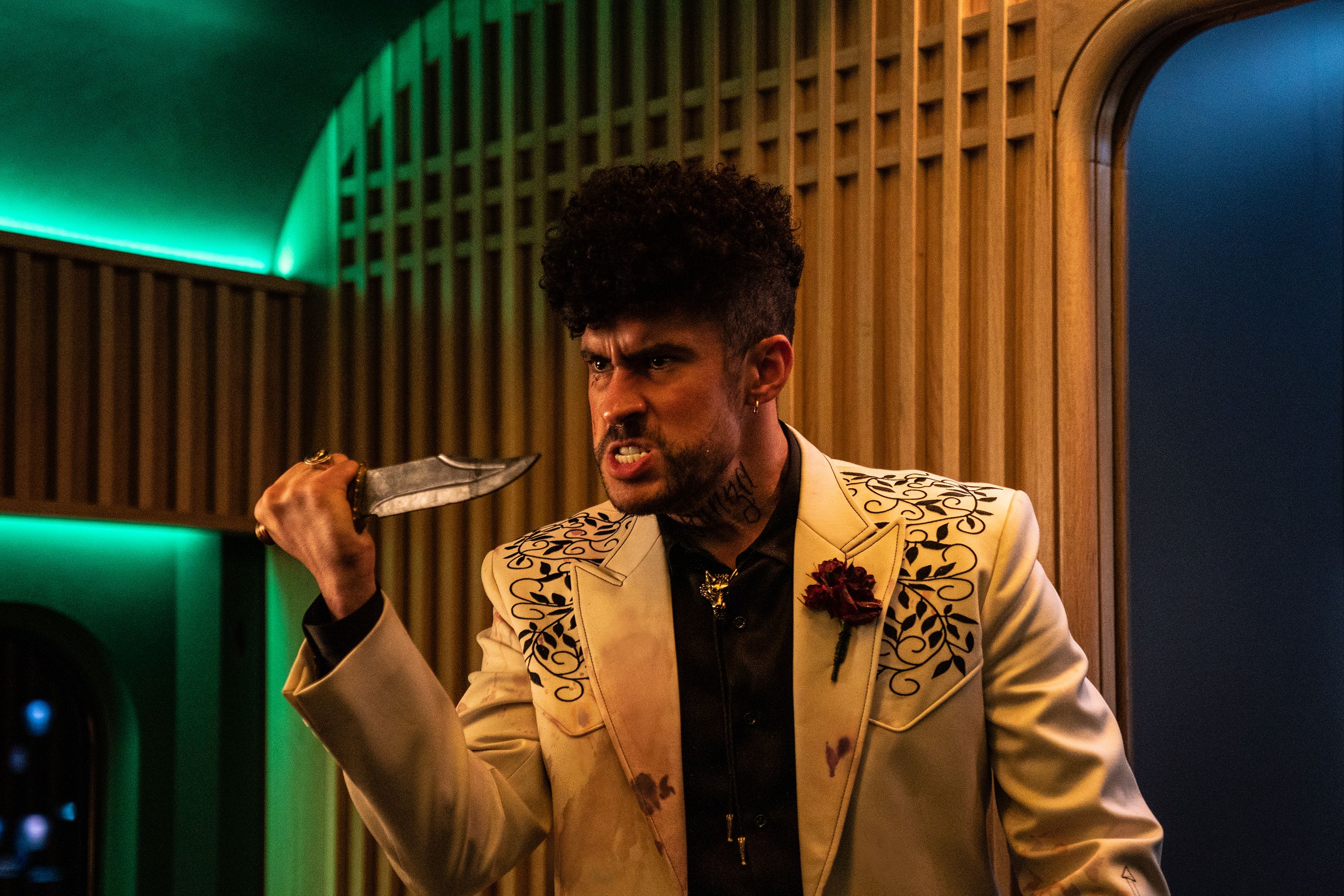
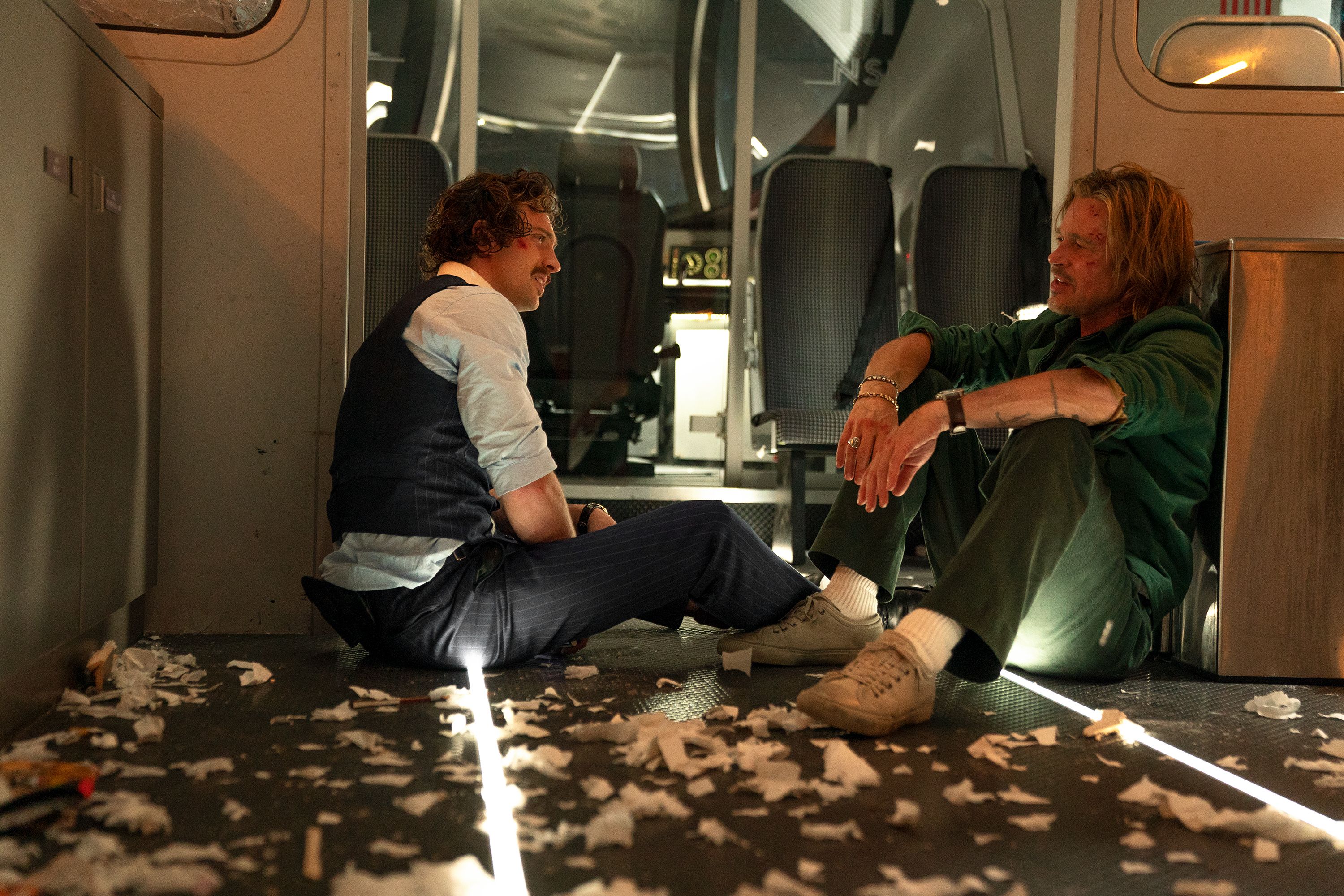
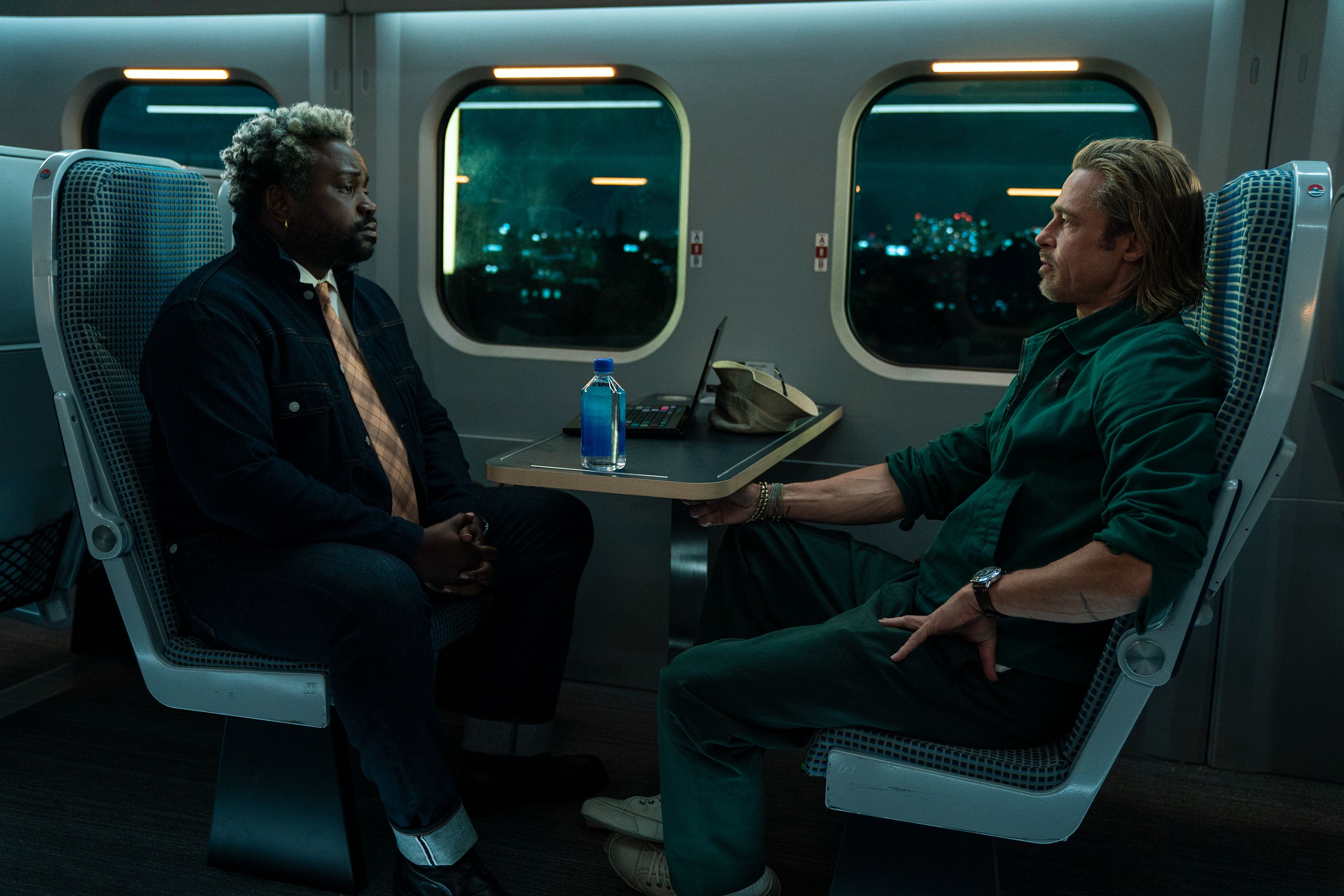
.jpg)
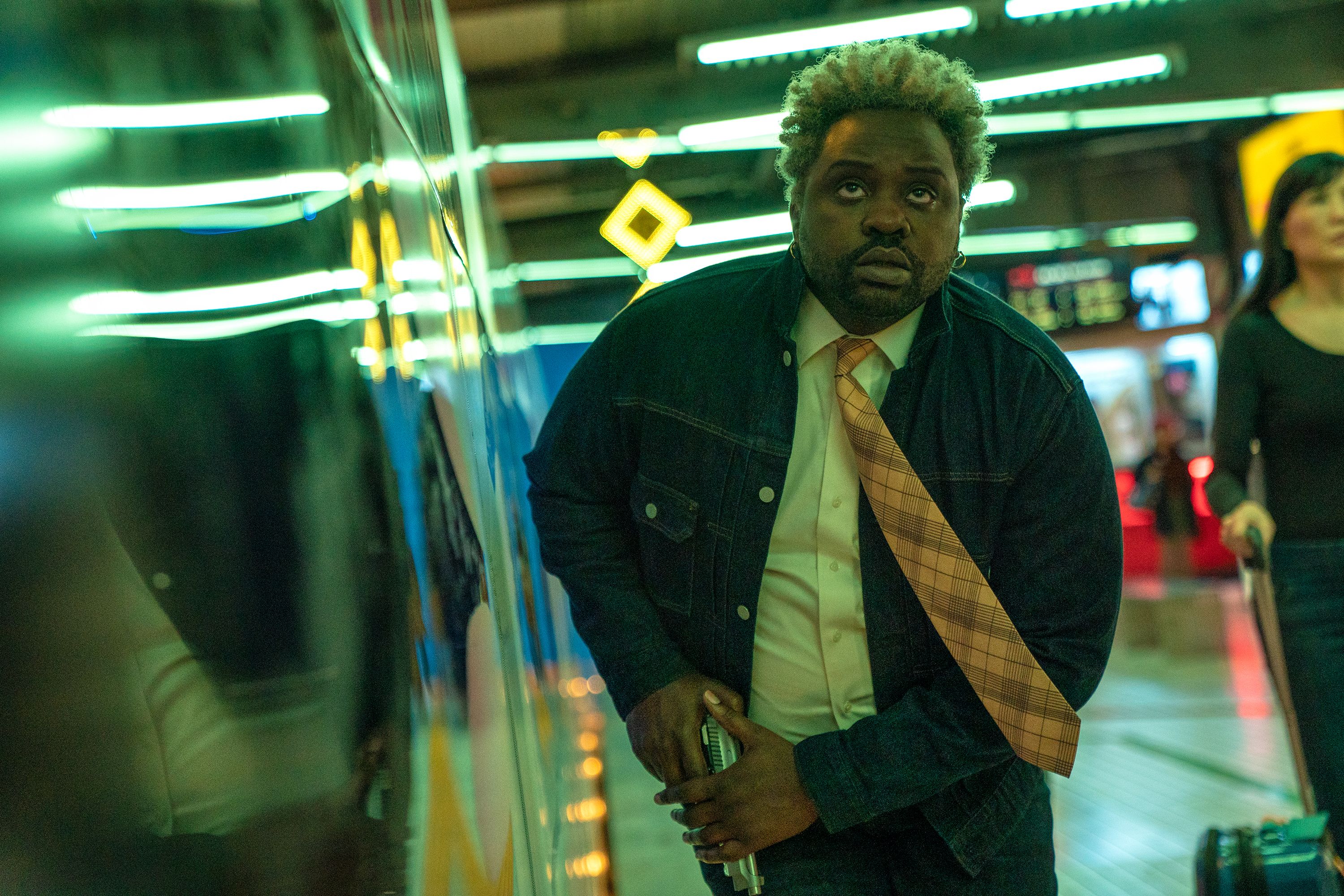
.jpg)
